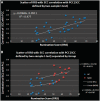Depression, rumination and the default network
- PMID: 20855296
- PMCID: PMC3190207
- DOI: 10.1093/scan/nsq080
Depression, rumination and the default network
Abstract
Major depressive disorder (MDD) has been characterized by excessive default-network activation and connectivity with the subgenual cingulate. These hyper-connectivities are often interpreted as reflecting rumination, where MDDs perseverate on negative, self-referential thoughts. However, the relationship between connectivity and rumination has not been established. Furthermore, previous research has not examined how connectivity with the subgenual cingulate differs when individuals are engaged in a task or not. The purpose of the present study was to examine connectivity of the default network specifically in the subgenual cingulate both on- and off-task, and to examine the relationship between connectivity and rumination. Analyses using a seed-based connectivity approach revealed that MDDs show more neural functional connectivity between the posterior-cingulate cortex and the subgenual-cingulate cortex than healthy individuals during rest periods, but not during task engagement. Importantly, these rest-period connectivities correlated with behavioral measures of rumination and brooding, but not reflection.
Figures



References
-
- Abler B, Hofer C, Viviani R. Habitual emotion regulation strategies and baseline brain perfusion. Neuroreport. 2008;19(1):21–4. - PubMed
-
- Beck AT, Steer RA, Brown GK. Manual for the Beck Depression Inventory-II. San Antonio, TX: Psychological Corporation; 1996.
Publication types
MeSH terms
Substances
Grants and funding
LinkOut - more resources
Full Text Sources
Other Literature Sources

